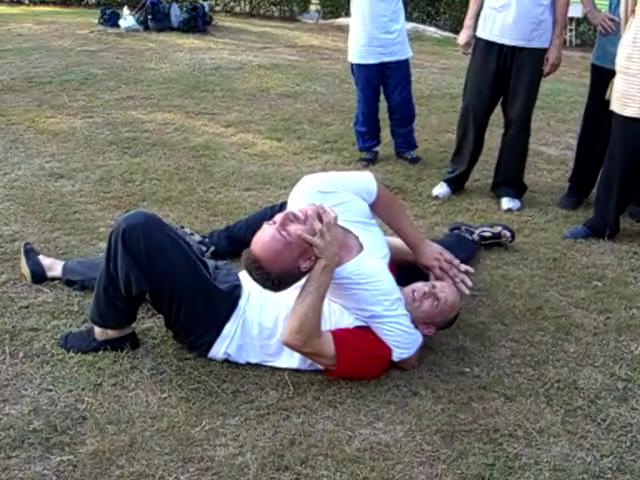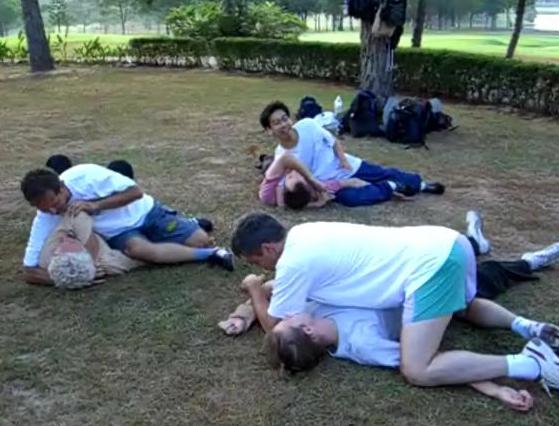TIGER-CLAWS AND COUNTERS AGAINST PIN-DOWNS
 Grandmaster Kai Uwe, an expert on ground-fighting, demonstrates using the Tiger-Claw to overcome a take-down by Sifu Anton
Grandmaster Kai Uwe, an expert on ground-fighting, demonstrates using the Tiger-Claw to overcome a take-down by Sifu Anton
The following discussion is reproduced from the thread Grappling and Kungfu started in the Shaolin Wahnam Discussion Forum on 18th April 2003
Juszczec
The Karate Guy
USA
22nd April April 2003
| Joints like the wrist, ankle, and elbow are good targets for “wronging joints.” |
This is a great description of what you are doing to someone when you attack their joints.
| The fingers are good for “separating tendons”. |
Does this mean you can use the fingers to attack the tendons or does it mean "wronging" the finger joints also "separate tendons"? I've seen some finger locks that do both, and I'm just curious.
| I've learned Chin Na from Dr. Yang. |
Good for you! I think his books are great and I like his ideas. What's training with him like?
| Tiger Claw is an Art, not just a technique. The Art of Tiger Claw includes techniques, skills, tactics, strategies, and force training methods. |
This seems to be the typical Chinese approach. There is a technique and surrounding it are methods to develop and use it.
| The methods for training Tiger Claw force are extensive. Coincidentally, some of these methods will be discussed in an article soon to be released by Sifu on his website. |
I'll keep an eye out (
![]() no pun intended) for it.
no pun intended) for it.
Editorial Note: Please see Training Methods of Tiger-Claw.
| And yes, it is mostly "strength," though it is not in the normal, external sense of the word. It uses an effective comination of external strength and internal force, skills, and techniques. |
This also seems to be a hallmark of kungfu. Learn how to do it, refine the tools needed to do it and understand when/where to do it.
| It can be done with a single hand. Joint manipulation is not necessary with a high-level Tiger Claw. |
I understand. I always tell our students they can use pain to create an opening, so after blocking find a soft part on the attacking limb and dig your fingers in as you counter.
| The nature of attacking makes you vulnerable to counter attack. |
True. My whole point (and I'm sure I expressed it badly) was that every attack has a counter and every counter has a counter and so on and so on and so on. Success is a combination of skill, opportunity and good luck.
| My point is that a tackle (what term should we use for the shoot?) is an extremely vulnerable attack that does not do a good job of minimizing the possibilities for counter. |
I'd call it a shoot, because tackle has different connotations due to soccer, rugby (I suspect) and American football.
Yes, it is an all or nothing kind of attack. Not much room for error, but great results if it lands. I think its chief strength is that it is relatively simple.
| Tearing off an ear is relatively easy. Anyone with a decent grip and a malicious intent can do it. Anatomically speaking, the ear is not attached very well. |
No kidding? Are you grabbing and pulling, grabbing and twisting or grabbing,twisting AND pulling?
I've never heard of such a vulnerability and want to learn more. Especially since I taught the "grab an ear and pull" technique to my son as a way to escape a grab about a month ago
|
But no, I have never torn off an ear, and I hope I never do. Nor have I done simulations. I have, however, grabbed an ear and pulled gently when forced to go to the ground. It wasn't a joint lock, but you could call it a submission technique.
|
I, too, hope you never find yourself in such a situation where this response would be appropriate. I prefer to think of such a technique as a potential fight ender or something to create an opening for more techniques that may end the confrontation.
Mark
 What would you do if an opponent has successfully taken you onto the ground? The picture above shows participants of the Special Combined Shaolin and Taijiquan Course of 2005, most of whom are masters themselves, practicing how to release themselves after being pinned onto the ground.
What would you do if an opponent has successfully taken you onto the ground? The picture above shows participants of the Special Combined Shaolin and Taijiquan Course of 2005, most of whom are masters themselves, practicing how to release themselves after being pinned onto the ground.
Anthony Korahais
USA
22nd April 2003
| Does this mean you can use the fingers to attack the tendons or does it mean "wronging" the finger joints also "separate tendons"? I've seen some finger locks that do both, and I'm just curious. |
I wasn't clear. Sorry. It means that you can manipulate your opponent's fingers to separate his tendons and cause blindingly-white-hot-ouch-please-stop-now-please pain.
| Good for you! I think his books are great and I like his ideas. What's training with him like? |
I like him a lot. Dr. Yang is charismatic, relaxed, and funny. He's a bit of a showman with the Chin Na, but with good reason -- he is very skillful at it. He is happy to demonstrate on just about anyone, especially if you're big and strong. I felt his technique many times, and I must say, it was incredibly painful, which is a compliment to his skill.
However, his Chin Na is purely external. It does not use internal force. It is pure scientific manipulation, but to a degree of sophistication much higher than anything I've seen in Aikido or Jujutsu. He's especially good at "separating tendons."
Training with him is, well...painful. That was my biggest complaint. Dr. Yang was very skillful and controlled, and so were all of his disciples. However, the others attending the seminar -- a motley crew of New York martial artists -- were not so controlled. As a violinist, I was very nervous about handing over my fingers to be manipulated in ways that can easily break them.
I prefer to work with this kind of stuff with people I know and trust. There were some questionable attitudes there. One guy tried to attack me (and several others) during a technique that was specifically stated and taught as a counter against a grab. Instead of grabbing me, he attacked me with a punch. So I counter-attacked, but not with what he was expecting. He looked down to find a Phoenix Eye and inch from his throat. After that, he was very polite.
![]()
Another guy was doing a beautiful Eagle Claw form during the break. I went to talk to him, and it turns out I know his Sifu(Leung Shum). A conversation ensued, and he immediately wanted to show me the "cool" applications for the form. Now, I'm pretty open with this stuff, but I found it odd when a complete stranger was insisting that I attack him.
Him: "So the punch comes in..."
Me: "What Punch? You want me to punch you?"
Him: "Yes, Horn Punch here...and when it comes in...the..."
Me: "You want me to punch you...with power?"
Him: "Yes, just punch...and then..."
So I punched him. My Horn Punch went right through all of his defenses and, had I not pulled it at the last second, would have smacked him in the temple. I apologized, but I really expected him to block -- effectively, that is.
The point of the story is that I was forced to work with martial artists of all shapes, sizes, and abilities. Unfortunately, this made the seminar a bit uncomfortable for me. If you can go with a friend you trust, it might be better.
| Not much room for error, but great results if it lands. I think its chief strength is that it is relatively simple. |
Agreed.
| No kidding? Are you grabbing and pulling, grabbing and twisting or grabbing,twisting AND pulling? |
I hate to share this, but since I raised the subject and I know the technique (from an old instructor with lots of street fighting experience), I'll mention it.
Grab near the center of the ear using the index finger and thumb. Grab with the thumb braced against the middle knuckle (not the tip) of the index finger. In Kungfu terms, it looks similar to a Phoenix Eye Fist. If you yank hard enough in the correct direction, the cartilage will come right off the skull. Even the wrong direction will be painful. You don't need to twist; just yank. On the ground (during sloppy wrestling) you can sometimes get an arm or a leg braced against his skull to get increased leverage for the pull. Very ugly, but not fatal.
OK. Enough of that. Kids, do not try this at home. Seriously. if you pull your own ear too hard, you can rip the cartilage. Please don't.
LINKS
